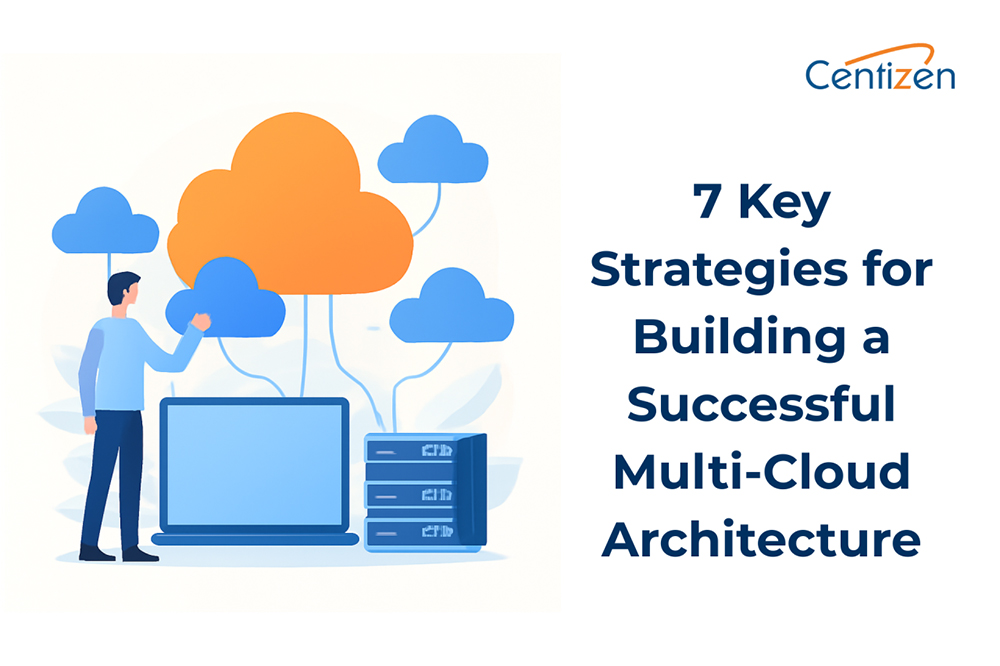7 Key Strategies for Building a Successful Multi-Cloud Architecture

“In 2025, enterprises that thrive will master one thing: agility across clouds. Here’s how to build a resilient multi-cloud architecture in 7 strategic steps.”
As businesses scale and digital demands intensify, relying on a single cloud provider is no longer a viable long-term strategy. Multi-cloud architecture—leveraging services from multiple cloud vendors—has become essential for flexibility, resilience, and competitive advantage. But adopting a multi-cloud strategy isn’t just about spreading workloads; it requires deliberate planning and execution.
Here are 7 key strategies to build a successful multi-cloud architecture that’s secure, scalable, and future-ready:
1. Define clear business objectives
Before choosing cloud platforms, outline what your organization wants to achieve—whether it’s reducing vendor lock-in, enhancing reliability, improving latency, or optimizing costs. Let your business goals guide the architecture, not the other way around.
2. Choose the right mix of cloud providers
Evaluate cloud vendors based on their strengths. AWS excels in compute scalability, Microsoft Azure offers strong enterprise integration, and Google Cloud is known for data analytics and AI. A smart combination tailored to your workload needs can drive better outcomes.
3. Standardize security and compliance frameworks
A fragmented cloud environment increases the risk of security gaps. Establish unified security protocols, IAM policies, and compliance checks across all platforms. Leverage cloud-agnostic tools for monitoring and threat detection wherever possible.
4. Embrace cloud-native and portable architectures
Use containers (like Docker) and orchestration tools (like Kubernetes) to ensure workload portability. This helps avoid being tied to one provider and makes it easier to shift or replicate services across clouds when needed.
5. Implement unified monitoring and management
Visibility is critical in a multi-cloud setup. Use centralized dashboards or observability platforms that integrate logs, metrics, and performance data from all your cloud environments in real time.
6. Optimize for cost and performance continuously
Multi-cloud does not mean more expensive—if managed wisely. Set budgets, use auto-scaling, and continuously audit resource usage. Tools like FinOps frameworks or cloud cost management platforms can help balance performance with cost-efficiency.
7. Build a skilled, cross-cloud team
Multi-cloud success depends on talent. Upskill your teams in each cloud provider’s ecosystem and tools. Encourage collaboration across DevOps, security, and finance teams to streamline governance and innovation.
Final Thoughts
Multi-cloud isn’t just a trend—it’s a strategic move toward resilience, innovation, and agility. By aligning cloud architecture with business priorities and enforcing consistency in security, performance, and governance, organizations can unlock the full power of a multi-cloud world.
Our services:
- Staffing: Contract, contract-to-hire, direct hire, remote global hiring, SOW projects, and managed services.
- Remote hiring: Hire full-time IT professionals from our India-based talent network.
- Custom software development: Web/Mobile Development, UI/UX Design, QA & Automation, API Integration, DevOps, and Product Development.
Our products:
- ZenBasket: A customizable ecommerce platform.
- Zenyo payroll: Automated payroll processing for India.
- Zenyo workforce: Streamlined HR and productivity tools.
Services
Send Us Email
contact@centizen.com
Centizen
A Leading Staffing, Custom Software and SaaS Product Development company founded in 2003. We offer a wide range of scalable, innovative IT Staffing and Software Development Solutions.
Call Us
India: +91 63807-80156
USA & Canada: +1 (971) 420-1700
Send Us Email
contact@centizen.com
Centizen
A Leading Staffing, Custom Software and SaaS Product Development company founded in 2003. We offer a wide range of scalable, innovative IT Staffing and Software Development Solutions.
Call Us
India: +91 63807-80156
USA & Canada: +1 (971) 420-1700
Send Us Email
contact@centizen.com






